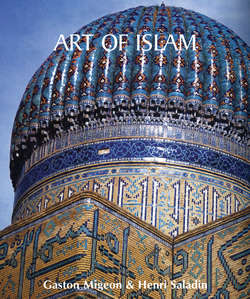Читать книгу Art of Islam - Gaston Migeon - Страница 20
На сайте Литреса книга снята с продажи.
Architecture
B – North Africa and Spain
The Great Mosque of Córdoba
ОглавлениеThe construction of the Great Mosque at Córdoba was begun in 785 by the first caliph of Spain, Abd-ar-Rahman. Hicham I completed it by extending its naves to the south between 793 and 796. Hakam II and Hakam III further extended it in 961–962 and 988–1001 respectively.
Córdoba’s Great Mosque has parallel naves with a larger central nave that leads to the mihrab. This mosque is architecturally different from the one in Kairouan. The influence of ancient and indigenous monuments was stronger here than in Tunisia. The Byzantine influence here is visible only in the decoration of the mihrab. Here, there are no massive minarets like those in Kairouan and Tunis, neither are there slender minarets like those in Susa, nor domes with cupolas like those in Kairouan. The same is true of the ornamentation. In Spain, Islamic decoration took an excessive turn that would remain a permanent feature of the artistic tradition.
The traditional plan of the mosque initially comprised eleven naves with columns, with a larger central nave that led to the mihrab. Hicham I extended it to the south; Hakam II added twelve naves to it; and Hakam III added eight, separated by seven rows of thirty-three columns, giving it its current dimensions. Short columns raised by arches that brace and support each other function as a beautiful solution to spatial limits: they make it possible to increase the height of the naves with minimal materials.
The mosque was decorated with ceilings placed under nets of parallel roof framings whose walls have gutters following a pattern widely used in the Maghreb. These worm-eaten roof framings were later replaced by light arches, except in the parts where the ancient ceilings were renovated.
Its dome frame is a replica of the neighbouring bay in the axis of the central nave, which is made of stone. Strikingly, the springing of the arches are supported by lion-shaped corbels. The stalactites visible above the multi-foil arch are in many ways similar to those which, in the Alcázar in Seville, are designed in the 15th-century Mudéjar style. The mosque’s minbar (Silla del Hey Almansor), which was pulled on four wheels like the Maliki minbars in Tunisia and Algeria, was stunning in both its material makeup and its design. Its construction, ordered by Hakem, began in 1236 and lasted nine years. It was destroyed in 1572.
Cupola of the mihrab in the Great Mosque of Córdoba, 971–976.
Córdoba.
Mihrab hall, the Great Mosque of Córdoba, 961–966.
Córdoba.
Court of the Lions, Alhambra, late 15th century.
Granada.
